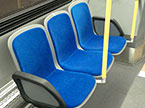Riding the Streetcar
Video: Boarding and exiting the low-floor streetcar
This video explains the accessible features of the low-floor streetcar, how to board and exit, and includes general safety tips for both customers and motorists.
How to recognize an accessible streetcar stop
On streetcar routes most stops are accessible, however, some stops may not yet be designated with the blue International Symbol of Access. At stops without streetcar platforms, accessible curb ramps are being installed for easier access to the second door of the streetcar. Where stops are not yet accessible, customers who need the ramp must use the stops before or after.
Route and destination announcements
All streetcars verbally announce the route and destination of the vehicle to customers waiting at each stop. This information is also displayed visually on the vehicle’s front, side, and rear destination signs.
Who can use the ramp?
TTC streetcars are designed to provide barrier-free access. The accessibility entrance and ramp are located at the second door of the vehicle. Anyone who feels they can benefit from the use of the ramp may request that it be activated. Simply press the flashing blue button at the second door of the vehicle when boarding. At on-street stops, the Operator will exit the vehicle and deploy the ramp for you. Note that the second door of the streetcar will remain closed while the ramp deploys. If you are using a manual wheelchair, Operator assistance up the ramp and into the vehicle is available.
When getting off the streetcar, press the blue button on the second door, or one of the blue buttons at the mobility device seating areas, to request the ramp at the next streetcar stop. When the streetcar stops, the other three doors will open first, and the second door will remain closed while the ramp deploys. Operator assistance is also available for manual wheelchair users when getting off the streetcar.
Note that in the event that your chosen stop is not accessible, the Operator will advise you to exit the vehicle at the next stop.
First on, last off
Customers using a mobility device are encouraged to board our vehicles first, before other customers and exit last, before others leave. Customers should be mindful of this when they see people using a mobility device.
Wheelchair and scooter positions
Streetcars have two onboard positions for wheelchairs and scooters. These are located at the second door of the streetcar. Look for the blue International Symbol of Access at the door. Please note that accessible streetcar mobility device seating areas are designed to accommodate mobility devices 1,220 mm long (48 inches) by 760 mm wide (30 inches).
Paying fares
Accessible streetcars operate on the Proof-of-Payment fare system.
Automated stop announcements on streetcars
All streetcars are equipped with automated next stop announcements to verbally and visually display the upcoming vehicle stop.
Need assistance onboard?
Emergency assistance is available. Press the yellow Emergency Alarm strip above most seating areas, the yellow Emergency Intercom button marked with a bell symbol at the mobility device areas, or use the Emergency Intercom button near all doorways.
- Use the Passenger Emergency Intercom to speak to the Operator if you’re on a streetcar
The intercom button is located on the wall in the middle of every streetcar, to the right of the raised circular Stop and Ramp Request button. It is positioned near the bottom of a two-way speaker and can be identified by a raised bell image within the circular button. When this button is pushed, a light will appear above it to indicate it has been pushed. You will also feel the button lower when you push it. The Operator will respond from his cab and you will be able to talk through the speaker. A talk light and listen light are also located above and to the left of the intercom button. These will light up when the system being used, but no further action is required from you in this area of the intercom.
Both the Stop and Ramp Request and Passenger Emergency Intercom buttons are at a located at an accessible height, making it easy for all customers to use.
Priority seating for seniors and persons with disabilities.
In accordance with the Accessibility for Ontarians with Disabilities Act 2005 (AODA), TTC provides Priority Seating on all of its vehicles, designated for use by persons with disabilities. You must give up these seats for a person who is disabled or has a physical limitation requiring priority seating. A customer with a disability occupying a priority seat is not required to move for another customer with a disability. In this situation, use of these seats is on a first-come, first-served basis. You are not required to give up your seat that is not designated priority seating. TTC encourages customer co-operation particularly as it relates to giving up seating for people with disabilities, elderly customers, and pregnant women.

Seats with blue fabric are designated priority seats. TTC By-law No 1 requires that you obey signs posted by the TTC, including Priority seating signs on TTC vehicles. Persons who do not comply with Priority Seating signs may be subject to penalties under this By-law and liable to a fine of $235.00 plus applicable charges.
Decals also indicate where priority seating is located. It is generally located near the entrance of vehicles.
More information can be found in the Priority Seating FAQ.
Request Stop program
The Request Stop program is not available on streetcars. Streetcars travel in the middle of the roadway too far from the sidewalk to let customers exit the vehicle safely at an unmarked stop.
Surface vehicle camera system
All streetcars are equipped with cameras to record activity that takes place within the vehicle. The cameras help to enhance customer and employee safety, and aid police in conducting investigations.
